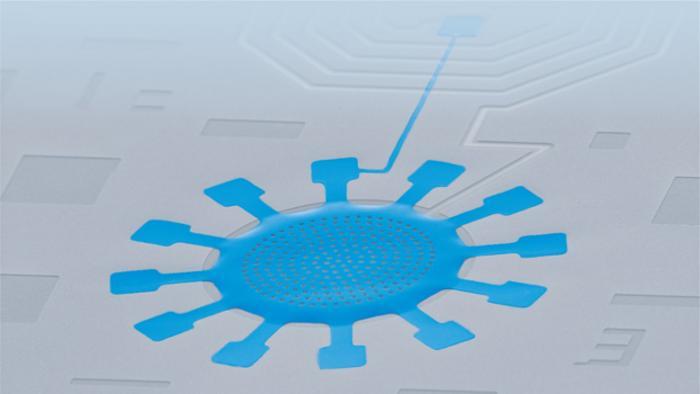During the past decade, researchers have made enormous advances in producing quantum phenomena in mechanical systems.

Scanning electron microscope image of an ultra-coherent superconducting electro-mechanical system. Image Credit: Amir Youssefi (École polytechnique fédérale de Lausanne)
What looked impossible only fifteen years ago has become a reality as scientists successfully make quantum states in macroscopic mechanical objects.
By coupling such mechanical oscillators to light photons called “optomechanical systems,” researchers have been able to cool them down to their lowest energy level close to the quantum limit, “squeeze them” to decrease their vibrations and entangle them with each other.
Such progress has set the stage for new possibilities in quantum sensing, basic tests of quantum gravity, compact storage in quantum computing, and also in finding dark matter.
To effectively operate optomechanical systems in the quantum regime, researchers experience a dilemma. As the first option, the mechanical oscillators should be properly separated from their environment to reduce energy loss.
In contrast, they should be well-coupled to other physical systems like electromagnetic resonators to regulate them.
Striking this balance requires increasing the oscillators’ quantum state lifetime affected by the oscillator’s frequency instabilities and the environment’s thermal fluctuations—what is called in the field “decoherence.”
This is a firm difficulty throughout several systems, from the gigantic mirrors utilized in gravitational wave detectors to small trapped particles in high vacuum. In comparison to other technologies like superconducting qubits or ion traps, the opto- and electro-mechanical systems available currently still display greater decoherence rates.
Currently, researchers at the laboratory of Tobias J. Kippenberg at EPFL have addressed the issue by coming up with a superconducting circuit optomechanical platform that displays ultra-low quantum decoherence while retaining huge optomechanical coupling that leads to high-fidelity quantum control.
The study has been reported recently in the journal Nature Physics.
In simple words, we demonstrated the longest quantum state lifetime ever achieved in a mechanical oscillator, which can be used as a quantum storage component in quantum computing and communication systems.
Amir Youssefi, PhD Student and Project Lead, Ecole Polytechnique Fédérale de Lausanne
Youssefi added, “This is a big achievement and impacts a wide range of audiences in quantum physics, electrical engineering, and mechanical engineering.”
The main element of the discovery is a so-called “vacuum-gap drumhead capacitor,” a vibrating element composed of a thin aluminum film that has been suspended over a trench in a silicon substrate. The capacitor acts as the vibrating component of the oscillator and also develops a resonant microwave circuit.
Through a novel nanofabrication method, the team considerably decreased mechanical losses in the drumhead resonator, obtaining an exceptional thermal decoherence rate of only 20 Hz, comparable to a quantum state lifetime of 7.7 ms—the longest ever obtained in a mechanical oscillator.
The exceptional reduction in thermally induced decoherence enabled the scientists to utilize the optomechanical cooling method, leading to a splendid 93% fidelity of the quantum state occupation in the ground state.
Besides, the team obtained mechanical squeezing below the zero-point fluctuation of motion, having a value of -2.7 dB.
“This level of control allows us to observe the free evolution of mechanical squeezed states preserving its quantum behavior for an extended period of 2 milliseconds, thanks to the exceptionally low pure dephasing rate of only 0.09 Hz in the mechanical oscillator,” stated Shingo Kono, who contributed to the research.
Such ultra-low quantum decoherence not only increases the fidelity of quantum control and measurement of macroscopic mechanical systems, but will equally benefit interfacing with superconducting qubits and places the system in a parameter regime suitable for tests of quantum gravity.
Mahdi Chegnizadeh, Member of the Research Team, Ecole Polytechnique Fédérale de Lausanne
Chegnizadeh added, “The considerably longer storage time compared to superconducting qubits makes the platform a perfect candidate for quantum-storage applications.”
Journal Reference
Youssefi, A., et al. (2023) A squeezed mechanical oscillator with millisecond quantum decoherence. Nature Physics. doi.org/10.1038/s41567-023-02135-y.